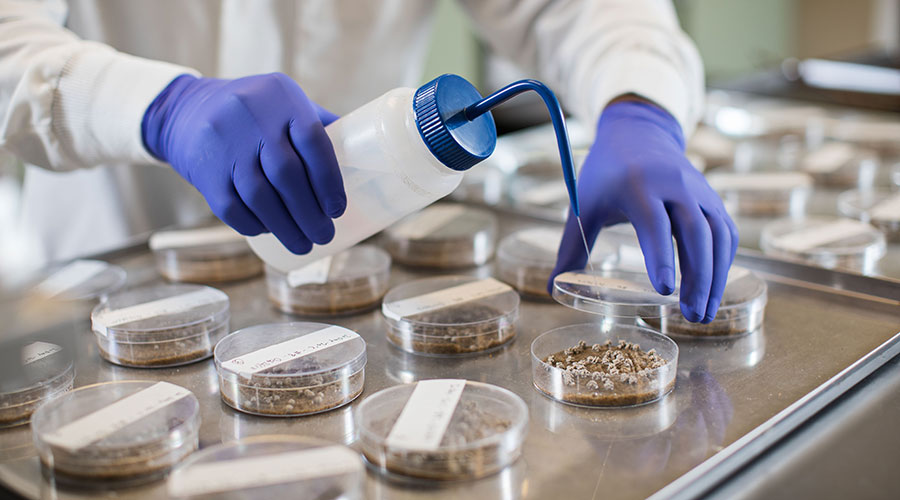Federal grant supports six projects at Centre for Boreal Research
Researchers at NAIT are turning to nanotechnology to kick-start the growth of native trees and shrubs used to reclaim thousands of former industrial sites in Alberta’s vast boreal forests.
Dr. Jean-Marie Sobze, Applied Research Chair – Plant and Seed Technologies with NAIT’s Centre for Boreal Research, says scientists currently struggle to germinate native boreal seeds. That’s partly because the coat – the exterior that protects the seed from the elements – is thick and prevents water from getting inside for months or longer, causing the seeds to go dormant. Typically, only about a third of dormant seeds from shrub species will sprout.
By treating seeds with nanotechnology – which hasn’t been attempted with native boreal seeds – the research team hopes to not only improve those odds, but to create seeds better adapted to germinate even in drought and other harsh environmental conditions such as soil high in salts.
“These nanoparticles can penetrate the seed coating and allow water to get into the embryo.”
“These nanoparticles can penetrate the seed coating and allow water to get into the embryo. We did a pilot project and saw a significant increase in germination,” says Sobze.
The nanotech seed study is one of six research projects planned at the centre that received $900,000 in funding recently from the Natural Sciences and Engineering Research Council of Canada (NSERC). Several industrial partners have contributed additional funding or in-kind support, including five forestry companies and corporations from the oilpatch.
Native seeds key to reclamation

With more than 80,000 inactive oil and gas wells in Alberta – many of which are in the boreal region, a swath of forest that covers 60% of the province – reclaiming forest and peatland is a lengthy and expensive task. It’s a major focus of study at the centre, whose investigators have doubled in number since it launched the land reclamation program in 2010 and have conducted 32 field trials across the boreal.
Reclaiming forest and peatland is a lengthy and expensive task.
Forest reclamation in the boreal requires seeds that are native to the region to produce a fully functioning ecosystem. Getting plants to take root can be a major challenge due to highly variable conditions at industrial sites themselves. The type of disturbance, age and level of activity at a site all affect soil quality and how plants grow.
Nano seeds a first for the boreal
Nano-coated seeds are commonplace in the agricultural industry, but this project will mark a first for use in Alberta’s boreal, Sobze says. Nanoparticles will help water penetrate the thick seed coat and kick-start growth.
One of the challenges of working with boreal seeds is time: some species just don’t grow in their first season. The majority of seeds produced in late-summer go dormant over the winter, he says, and “waking them up is very difficult.”
Researchers have tried different techniques to speed the process, such as mimicking springtime conditions in the centre’s greenhouses through lower temperatures and humidity – a process called stratification. Often it’s not until microorganisms and bacteria break down the seed coatings that water starts to penetrate the embryo and kick-starts growth, or germination. That can take months or even a full year, Sobze says.
Sobze will be studying which species might benefit from nano-coatings, such as chokecherries, highbush cranberries, pin cherry and beaked hazelnut. Seedlings will be planted in a variety of soil conditions that simulate real-world conditions at former industrial sites.
Growing a seed orchard
Native seeds come with their own set of challenges, most notably cost and quality. Shrubs like buffaloberry and green alder can be 10 times more expensive than tree species such as pine and spruce.
Sobze says the high cost is due to the fact that seeds are collected in a very manual process that involves scouting for berries in the bush. The berries researchers manage to collect vary in quality and quantity.
“When you’re spending time, you’re spending money.”
“You have to spend hours in the bush finding a small patch [of berries]. It’s time consuming and when you’re spending time, you’re spending money.”
Researchers at the centre have eyed a potential solution: creating an orchard of shrub seeds native to the boreal. The seed orchard is akin to farming native seeds, Sobze says, where all the seeds grow in one place.
This would reduce the need for inefficient excursions into the wild. It would also allow researchers to improve the quality by selecting top-quality plants and help address the problem of only a third of seeds germinating, he adds.